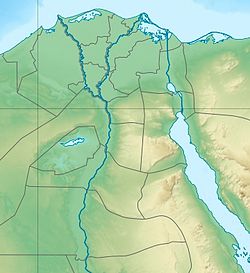
The Great Pyramid of Giza is the largest Egyptian pyramid. It served as the tomb of pharaoh Khufu, who ruled during the Fourth Dynasty of the Old Kingdom. Built c. 2600 BC, over a period of about 26 years, the pyramid is the oldest of the Seven Wonders of the Ancient World, and the only wonder that has remained largely intact. It is the most famous monument of the Giza pyramid complex, which is part of the UNESCO World Heritage Site "Memphis and its Necropolis". It is situated at the northeastern end of the line of the three main pyramids at Giza.
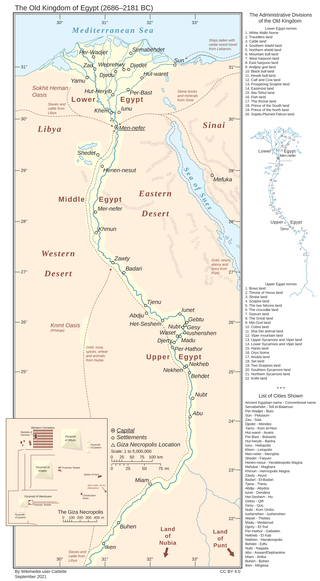
In ancient Egyptian history, the Old Kingdom is the period spanning c. 2700–2200 BC. It is also known as the "Age of the Pyramids" or the "Age of the Pyramid Builders", as it encompasses the reigns of the great pyramid-builders of the Fourth Dynasty, such as King Sneferu, under whom the art of pyramid-building was perfected, and the kings Khufu, Khafre and Menkaure, who commissioned the construction of the pyramids at Giza. Egypt attained its first sustained peak of civilization during the Old Kingdom, the first of three so-called "Kingdom" periods, which mark the high points of civilization in the lower Nile Valley.
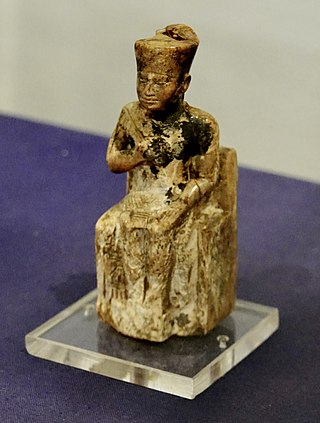
Khufu or Cheops was an ancient Egyptian monarch who was the second pharaoh of the Fourth Dynasty, in the first half of the Old Kingdom period. Khufu succeeded his father Sneferu as king. He is generally accepted as having commissioned the Great Pyramid of Giza, one of the Seven Wonders of the Ancient World, but many other aspects of his reign are poorly documented.

Menkaure or Menkaura was a king of the Fourth Dynasty of Egypt during the Old Kingdom. He is well known under his Hellenized names Mykerinos, in turn Latinized as Mycerinus, and Menkheres. According to Manetho, he was the throne successor of king Bikheris, but according to archaeological evidence, he was almost certainly the successor of Khafre. Africanus reports as rulers of the fourth dynasty Sôris, Suphis I, Suphis II, Mencherês (=Menkaure), Ratoisês, Bicheris, Sebercherês, and Thamphthis in this order. Menkaure became famous for his tomb, the Pyramid of Menkaure, at Giza and his statue triads, which showed him alongside the goddess Hathor and various regional deities.

The Great Sphinx of Giza is a limestone statue of a reclining sphinx, a mythical creature with the head of a human and the body of a lion. Facing directly from west to east, it stands on the Giza Plateau on the west bank of the Nile in Giza, Egypt. The face of the Sphinx appears to represent the pharaoh Khafre. The original shape of the Sphinx was cut from bedrock, and has since been restored with layers of limestone blocks. It measures 73 m (240 ft) long from paw to tail, 20 m (66 ft) high from the base to the top of the head and 19 m (62 ft) wide at its rear haunches.

The Egyptian pyramids are ancient masonry structures located in Egypt. Sources cite at least 118 identified "Egyptian" pyramids. Approximately 80 pyramids were built within the Kingdom of Kush, now located in the modern country of Sudan. Of those located in modern Egypt, most were built as tombs for the country's pharaohs and their consorts during the Old and Middle Kingdom periods.

The Fourth Dynasty of ancient Egypt is characterized as a "golden age" of the Old Kingdom of Egypt. Dynasty IV lasted from c. 2613 to 2494 BC. It was a time of peace and prosperity as well as one during which trade with other countries is documented.

The pyramid of Menkaure is the smallest of the three main pyramids of the Giza pyramid complex, located on the Giza Plateau in the southwestern outskirts of Cairo, Egypt. It is thought to have been built to serve as the tomb of the Fourth Dynasty King Menkaure.

The Giza pyramid complex in Egypt is home to the Great Pyramid, the Pyramid of Khafre, and the Pyramid of Menkaure, along with their associated pyramid complexes and the Great Sphinx. All were built during the Fourth Dynasty of the Old Kingdom of ancient Egypt, between c. 2600 – c. 2500 BC. The site also includes several temples, cemeteries, and the remains of a workers' village.
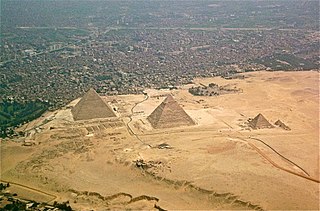
The Giza Plateau is a limestone plateau in Giza, Egypt, the site of the Fourth Dynasty Giza pyramid complex, which includes the pyramids of Khufu, Khafre and Menkaure, the Great Sphinx, several cemeteries, a workers' village and an industrial complex. It forms the northernmost part of the 160 km2 (62 sq mi) Pyramid Fields in the Western Desert edge of the Nile Valley that are part of the UNESCO World Heritage Site, Memphis and its Necropolis.

The Khufu ship is an intact full-size solar barque from ancient Egypt. It was sealed into a pit alongside the Great Pyramid of pharaoh Khufu around 2500 BC, during the Fourth Dynasty of the ancient Egyptian Old Kingdom. Like other buried Ancient Egyptian ships, it was part of the extensive grave goods intended for use in the afterlife. The Khufu ship is one of the oldest, largest, best preserved vessels from antiquity. It is 43.4 metres (142 ft) long, 5.9 metres (19 ft) wide, and 1.78 meters deep, and is the world's oldest intact ship. It has been described as "a masterpiece of woodcraft" that could sail today if put into a lake or a river.
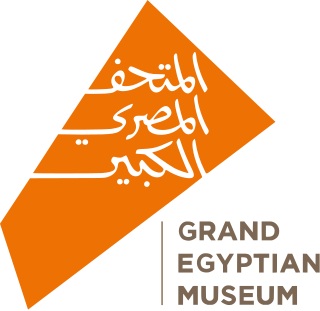
The Grand Egyptian Museum, also known as the Giza Museum, is an archaeological museum under construction in Giza, Egypt, about 2 kilometres from the Giza pyramid complex. The Museum will host over 100,000 artifacts from ancient Egyptian civilization, including the complete Tutankhamun collection, and many pieces will be displayed for the first time. With 81,000 m2 (872,000 sq ft) of floor space, it will be the world's largest archeological museum. It is being built as part of a new master plan for the Giza Plateau, known as "Giza 2030".
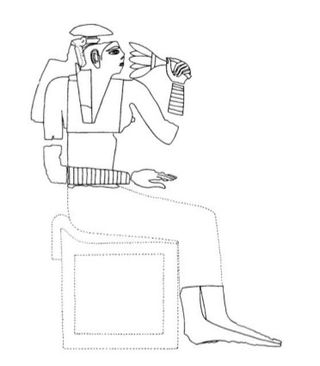
Hetepheres I was a queen of Egypt during the Fourth Dynasty of Egypt who was a wife of one king, the mother of the next king, the grandmother of two more kings, and the figure who tied together two dynasties.
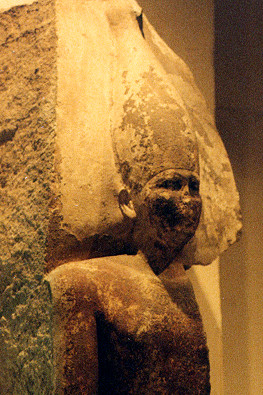
Sneferu or Soris was an ancient Egyptian monarch and the first pharaoh of the Fourth Dynasty of Egypt, during the earlier half of the Old Kingdom period. He introduced major innovations in the design and construction of pyramids, and at least three of his pyramids survive to this day.

Kamal el-Mallakh was a famous Egyptian archaeologist who was among the Egyptian antiquities inspectors who discovered the King Khufu Solar ship in 1954.
Meritites I was an ancient Egyptian queen of the 4th Dynasty. Her name means "Beloved of her Father". Several of her titles are known from a stela found at Giza. She was buried in the middle Queen’s Pyramid in Giza.

The Abydos boats are the remnants of a group of ancient royal Egyptian ceremonial boats found at an archaeological site in Abydos, Egypt. Discovered in 1991, excavation of the Abydos boats began in 2000 at which time fourteen boats were identified. They are located alongside the massive mudbrick structure known as Shunet El Zebib, attributed to the 2nd Dynasty Pharaoh Khasekhemwy. Shunet El Zebib is one of several such "enclosure wall" constructions at this site dating back to the 1st Dynasty, and is located nearly one mile from the early dynastic royal cemetery of Umm El Qa'ab.

Several ancient Egyptian solar ships and boat pits were found in many ancient Egyptian sites. The most famous is the Khufu ship, which is now preserved in the Grand Egyptian Museum. The full-sized ships or boats were buried near ancient Egyptian pyramids or temples at many sites. The history and function of the ships are not precisely known. They are most commonly created as a "solar barge", a ritual vessel to carry the resurrected king with the sun god Ra across the heavens. This is a common theme in the Pyramid Texts, and these buried boats might be a real-life equivalent of solar barges. Similarly, another explanation behind these boats is that they were built for past kings to carry them to the afterlife. Because of these ships' association with the sun, they are often found in an east-west orientation in order to follow the path of the sun.

Solar barques were the vessels used by the sun god Ra in ancient Egyptian mythology. During the day, Ra was said to use a vessel called the Mandjet or the Boat of Millions of Years, and the vessel he used during the night was known as the Mesektet.
The Diary of Merer is the name for papyrus logbooks written over 4,500 years ago by Merer, a middle-ranking official with the title inspector. They are the oldest known papyri with text, dating to the 26th year of the reign of Pharaoh Khufu during the Fourth Dynasty of Egypt. The text, written with (hieratic) hieroglyphs, mostly consists of lists of the daily activities of Merer and his crew. The best preserved sections document the transportation of white limestone blocks from the Tura quarries to Giza by boat.

